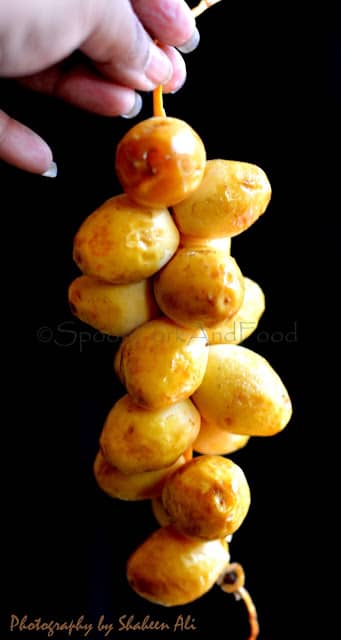
Few days back we had guest at home from KSA , i was so pleased to see that they got lots of hand plucked yellow dates for us. Never seen before, it was a something very new to me. Tasted very much like our Indian Desi Berr. A kind of sweet, a kind of sour … simply loved it. Thank you so much Abdullah Khan for this priceless gift https://www.facebook.com/mohammed.a.khan.7503?fref=ts

Dates have been a staple food of the Middle East and the Indus Valley for thousands of years. They are believed to have originated around what is now Iraq, and have been cultivated since ancient times from Mesopotamia to prehistoric Egypt, possibly as early as 4000 BCE. The Ancient Egyptians used the fruits to make date wine, and ate them at harvest. There is archaeological evidence of date cultivation in eastern Arabia in 6000 BCE.
There is also archeological evidence of date cultivation in Mehrgarh around 7000 BCE, a Neolithic civilization in what is now western Pakistan. Evidence of cultivation is continually found throughout later civilizations in the Indus Valley, including the Harappan period 2600 to 1900 BCE.
In later times, traders spread dates around South West Asia, northern Africa, and Spain. Dates were introduced into Mexico and California by the Spaniards in 1765, around Mission San Ignacio.
A date palm cultivar, known as Judean date palm is renowned for its long-lived orthodox seed, which successfully sprouted after accidental storage for 2000 years. This particular seed is presently reputed to be the oldest viable seed but the upper survival time limit of properly stored seeds remains unknown.
Fossil records show that the date palm has existed for at least 50 million years. [source Wikipedia]

Dates provide a wide range of essential nutrients, and are a very good source of dietary potassium. The sugar content of ripe dates is about 80%; the remainder consists of protein, fiber, and trace elements including boron, cobalt, copper, fluorine, magnesium, manganese, selenium, and zinc. The glycemic index for three different varieties of dates are 35.5 (khalas), 49.7 (barhi) and 30.5 (bo ma’an).
The caffeic acid glycoside 3-O-caffeoylshikimic acid (also known as dactylifric acid) and its isomers, are enzymic browning substrates found in dates.
Date seeds are soaked and ground up for animal feed. Their oil is suitable for use in soap and cosmetics. Date palm seeds contain 0.56–5.4% lauric acid. They can also be processed chemically as a source of oxalic acid. The seeds are also burned to make charcoal for silversmiths, and can be strung in necklaces. Date seeds are also ground and used in the manner of coffee beans, or as an additive to coffee. Experimental studies have shown that feeding mice with the aqueous extract of date pits exhibit anti-genotoxic and reduce DNA damage induced by N-Nitroso-N-methylurea










